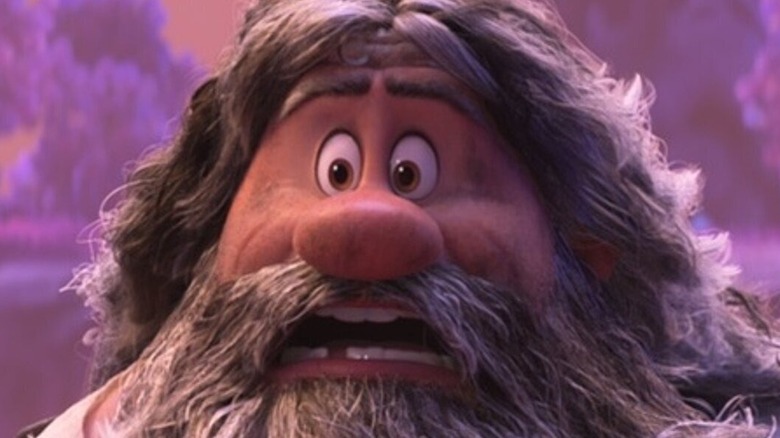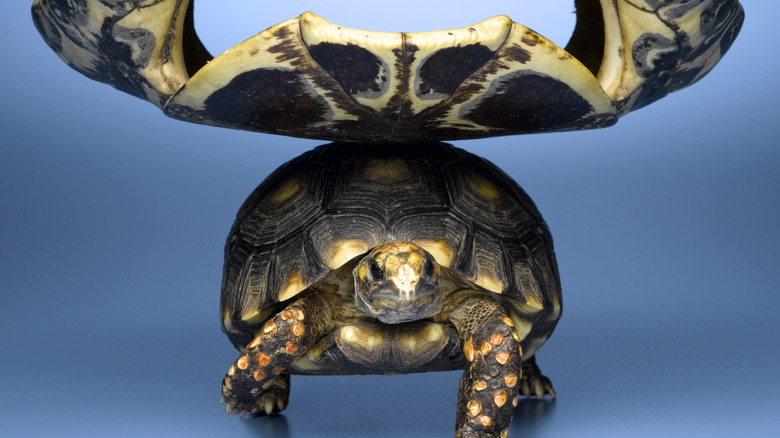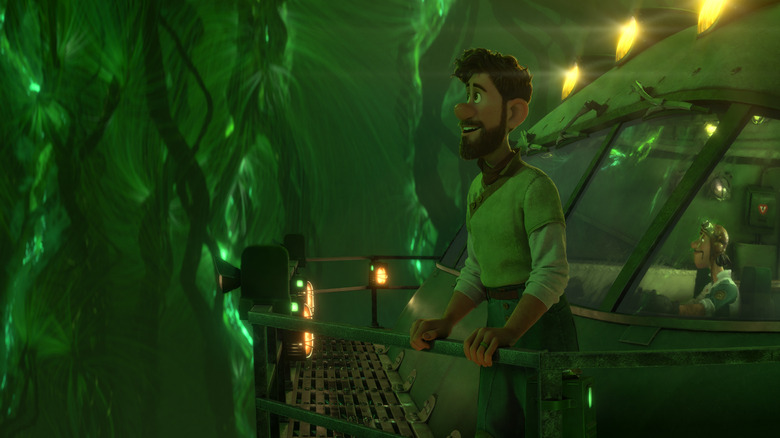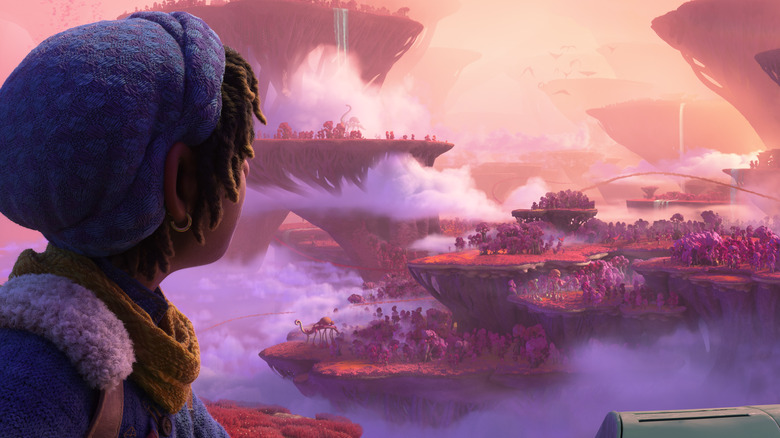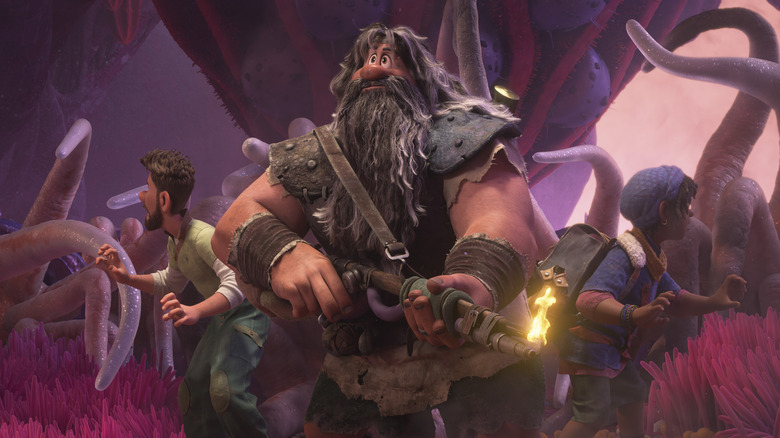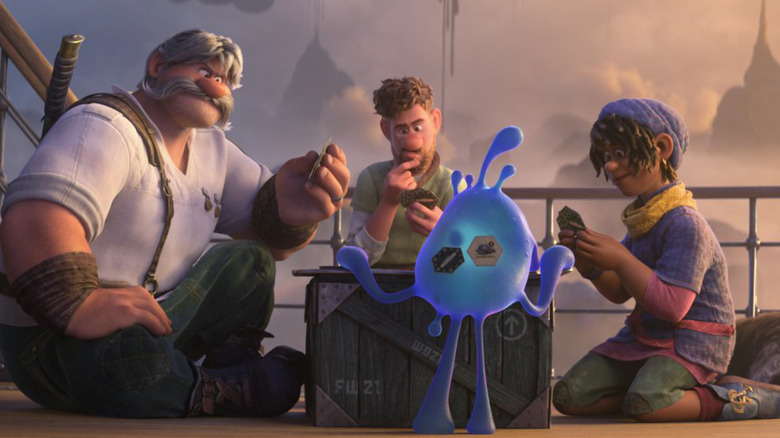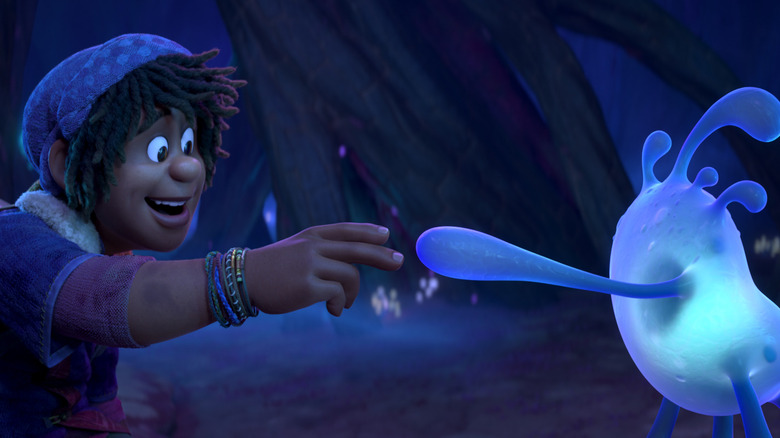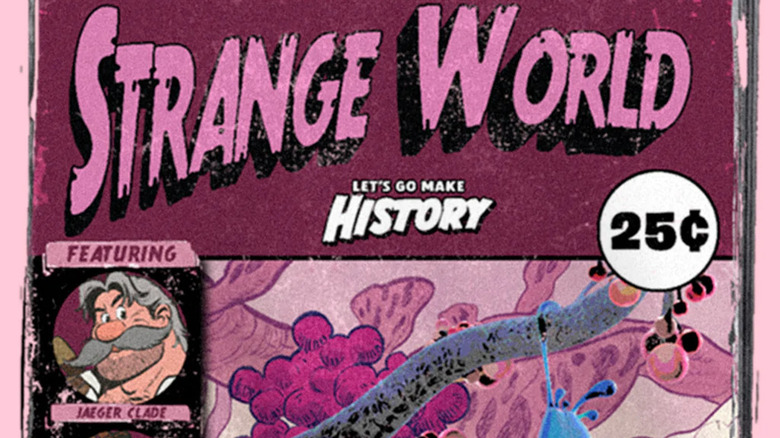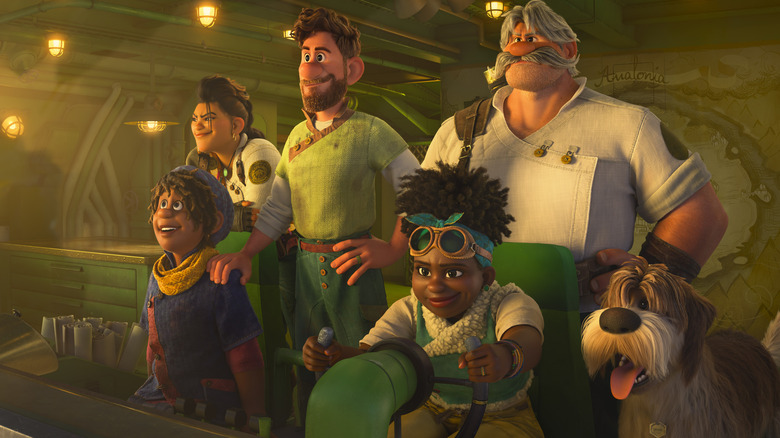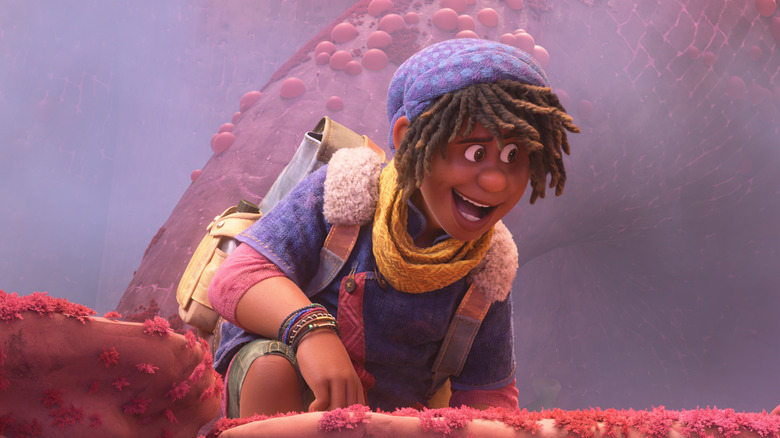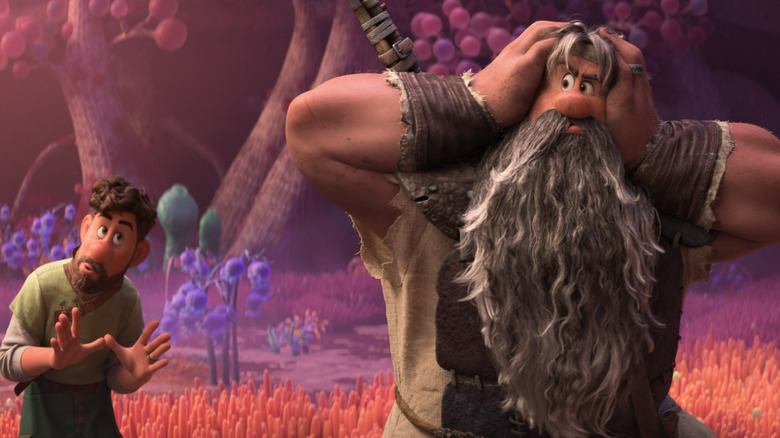The Ending Of Strange World Explained
We may receive a commission on purchases made from links.
Disney's "Strange World" is an alt-history, sci-fi/fantasy, CG-animated adventure film, told in the style of old pulp novels from the '30s-'50s. In essence, there's a lot going on.
Its story follows three generations of a legendary family named the Clades. There's the archetypical macho adventurer Jaeger (voiced by Dennis Quaid), who got lost on an expedition years ago. Then there's his son Searcher (Jake Gyllenhaal), more scientifically-minded, and — due to abandonment issues and trauma — raising his own son Eugene to stay away from adventuring. When the world is in danger and the government asks Searcher to use his knowledge to explore the titular "strange world," which — along with his family — could hold the key to the world's salvation, old family conflicts rise back to the surface, and uneasy alliances must be forged.
The film itself is filled with exciting action sequences, emotionally-charged meditations on family and the damaging effects of toxic masculinity, and a prescient environmental message to boot. "Strange World" is well worth watching in theaters on the big screen, if nothing else than for the amazing retro future designs and the uniquely surreal world from the title. It also boasts great messages about tolerance, inclusivity, and the importance of fighting for the future right now in the present.
The film also leaves some viewers with lingering questions, so below is a (spoiler-heavy) breakdown of the "Strange" things you might find yourself pondering as the credits roll.
The Turtles All the Way Down theory
One of the biggest, and indeed strangest, reveals in "Strange World" is the nature of the film's world itself. While it was always made obvious that "Strange World" was set in some form of alt-history, given the retro future airships and plant-based energy, it's no less a surprising reveal to learn that the entire world is actually on the back of a giant turtle-like creature, resting in the ocean.
While this might seem random, the filmmakers are likely making an overt reference to the "turtles all the way down" theory. While its exact origin is up for debate (some attribute it to Hindu mythology, and there are similar stories in Native American and Chinese cultures), it is commonly used to exhibit the problem of infinite regress and the chicken-or-egg-like question of who is holding whatever is holding the Earth. As a Jesuit priest wrote in 1599:
"Others hold that the earth has nine corners by which the heavens are supported. Another disagreeing from these would have the earth supported by seven elephants, and the elephants do not sink down because their feet are fixed on a tortoise. When asked who would fix the body of the tortoise, so that it would not collapse, he said that he did not know."
In his 1988 bestseller "A Brief History of Time," Stephen Hawking seemingly renewed the theory for the modern age with his own anecdote:
"A well-known scientist (some say it was Bertrand Russell) once gave a public lecture on astronomy. He described how the earth orbits around the sun and how the sun, in turn, orbits around the centre of a vast collection of stars called our galaxy. At the end of the lecture, a little old lady at the back of the room got up and said: "What you have told us is rubbish. The world is really a flat plate supported on the back of a giant tortoise." The scientist gave a superior smile before replying, "What is the tortoise standing on?" "You're very clever, young man, very clever," said the old lady. "But it's turtles all the way down!"
As far as pop culture is concerned, up until now the theory's most successful personification has come in "Yertle the Turtle," the anti-authoritarian children's book published in 1950 by Dr. Seuss.
This all fits with the "Strange World" themes of people stubbornly thinking they know something — such as Jaeger's faith in a world on the other side of the mountains, or Searcher's devotion to farming the harmful Pando plant — unaware that there is much more to discover and learn. If people don't think deeper or work to educate themselves, they'll be stuck believing impossible and outlandish things — like, you know, the world being held up by turtles.
Pando is an allegory for fossil fuels
In the film, Searcher Clade, who has a much more inquisitive and scientific mind than his more brash and impulsive father Jaeger, finds a glowing plant he nicknames "Pando" on one of their adventurous expeditions. While Jaeger is unimpressed with the discovery, and decides to keep going on with his initial expedition, Searcher takes the Pando plant back to his home country of Avalonia. Within the next couple decades, everything in Avalonia becomes run by the plant's energy — from radios and coffee machines to futuristic airships.
But eventually Searcher find out that the Pando crops are dying out, which is what kicks off the expedition into the eponymous "strange world" where the source of Pando can be found. Initially, Searcher and the crew are only there to find out what's going wrong with the plant, but it is eventually discovered that the cultivation of Pando itself is killing the planet, which turns out to be a literal living creature.
Upon discovering this, the President of Avalonia — Callisto Mal (Lucy Liu) — initially captures and imprisons the main characters for daring to suggest the government stop cultivating Pando, due to how profitable it is for the country. She relents in the end, though, when she realizes that short-term gain is not important if the whole planet dies.
The film is not subtle with the moral messaging in its climax, a call to action for not only government leaders to enact radical change to find viable alternate resources to save our own planet, but also for people to be willing to give up comforts to help with such change.
How Avalonia finds a new energy source
While the film is essentially a cautionary environmental tale about the dangers of vital resource depletion, it is also about the necessity of using alternative energy sources.
In the film, after Searcher is convinced by Eugene to stop using Pando as an energy source, the world goes dark for a year. Afterwards — with the help of another expedition Eugene goes on — Avalonia works together with the fantastical creatures living inside their giant turtle-world to receive more ethical, less exploitative energy from them. This lets Avalonians relight their electronics and return to some semblance of normalcy, without the looming threat of ecological disaster looming over them.
Unfortunately, in reality, there is no secret underground world with nigh-magical sentient creatures that can be negotiated with. But there are plausible alternatives like solar power, wind power, hydropower, even nuclear power that could be a saving grace. As depicted in the film, it will require significant growing pains and a change of current lifestyles.
Strange World sequel possibilities
Since "Strange World" is based, in large part, on old pulp adventure novels and comics — similar to the origins of things like "Indiana Jones" and "The Rocketeer " — further exciting adventures involving the Clade family feel like they could be possible. The genre is frequently episodic, and if the movie does well enough at the box-office, sequels seem like a distinct possibility.
There may be a firm conclusion at the end of this film — with Jaeger finally fulfilling his destiny of seeing the other side of the mountains, and Searcher and Eugene discovering the true nature of their world — but that doesn't mean it is the end of their adventuring.
The first film seems to only scratch the surface of what the titular "strange world" has to offer. The characters were very focused on their mission at hand — saving Avalonia — and so, they didn't fully explore everywhere they could go. Could there be other giant landmass creatures? Perhaps one on the other side of the world? With so much left to be discovered in, say, the ocean, it feels like the possibilities are endless.
Role of Settlers of Catan in solution to film's climax
Since the setting of the film is a sort of retro-future inspired alternate world history, there doesn't seem to be any cellphones or videogames. There is, however, a popular tabletop boardgame that Eugene is really into, and it seems to be based heavily on the real-world classic game "Settlers of Catan."
In both "SoC" and the fictional game in "Strange World," the players are trying to utilize the resources of the game's fictional world to maintain a balanced eco-system — which involves not just using tools to cultivate and create items from said resources, but also to work together and negotiate with the other players towards a common goal.
In the film, Eugene offers to teach the rules of the game to his father and grandfather, an attempt at conflict resolution. But Searcher and Jaeger just talk about conquering and killing the native creatures, or hoarding and over-harvesting the resources, and Eugene gets frustrated. Eventually, due to neither of them understanding the point of the game, they both lose.
This scene becomes important to the entire message and theme of the film: Learning to live harmoniously with the world around you, and not try to exploit or conquer it. This is true of Jaeger seeing nothing but enemies and danger, and Searcher not understanding for a while that his harvesting of Pando was causing the death of the planet.
No villains or antagonists
There's a poignant line, when playing the boardgame, where Jaeger asks who the bad guys are. The optimistic Eugene pointedly mentions there doesn't always have to be good guys or bad guys, and that working together for a common goal is sometimes the most important thing.
While this sentiment of working together and not looking for enemies foreshadows the climax, it's also something that helps make the film stand out. The need to have some sort of external threat in films can sometimes feel overused; often, "adventure" stories will make the natives, or even just the harshness of nature itself, an antagonistic force that must be conquered.
Instead, the story in "Strange World" is all about cooperation, healing, and redemption. As it turns out, all the creatures attacking the ship and crew throughout the film were simply trying to protect their world (in this case, a literal living creature) against the humans, who were the ones causing all the damage by extracting Pando from the creature's heart. The resolution, then, was the humans deciding to work together to help the creatures, rather than destroy or subdue them. Even the human conflicts — between Jaeger and Searcher, and later between the Clade family and the Avalonian government — are resolved via cooperation and radical change rather than traditional means.
Who is reading the comic? Is any of the story actually real?
At the very end of the film, it is revealed that the whole story was inside of a "Strange World"-branded comic book, with the camera pulling back from the turtle-shaped world of Avalonia and the image turning into a 2D drawing. The comic itself is situated on a wooden table among a bunch of adventuring tools (magnifying glass, maps, compasses) and the comic strip is closed right before the end credits roll.
This is all a callback to the opening of the film, which began with a bombastic, heroic theme song and pulpy comic-book-inspired visuals. Even one of Jaeger's flashbacks — where he describes how he survived living in the strange underground world for so long — is in the style of a comic book.
This begs the question: was anything that happened in the film real (as in, did it actually happen diegetically)? Or was it all just a fictional adventure story, even within the reality of the film? The ending leaves the answer ambiguous. But it's also possible that the comic book is about the "real" Clades, and that whoever is reading it exists in the world of the film, and is learning about their actual historical escapades.
Jaeger mends his toxic relationships
Disney's "Strange World" refreshingly deconstructs the overtly colonialist and imperialist themes of the original pulp novels that it follows. In fact, Jaeger Clade is pretty much the archetypal — almost to the point of parody — "man conquers all" aspirational hero of a bygone age; here, he learns the error of his ways. Throughout the film, he is seen for the toxic, selfish person those characters may have often been.
Not only does he realize he needs to apologize and make amends to the son he essentially abandoned, but also that his ambitions (which he claims were about him and his son's "legacy") were only about himself. Once he realizes that, his redemption comes when he forgoes his ambitions, and instead decides to help heal and mend not just the world, but his relationship with his family as well.
He even mends the relationship with his ex-wife and Searcher's mother. When Searcher initially tells him that he was raised by his step-dad (since Jaeger went missing while Searcher was very young), Jaeger is furious, and claims to want to kill the stepfather. His tune changes soon enough, replaced by hugs.
In the end, Jaeger is able to respect Searcher's more quiet, modest lifestyle, and realizes conquering new worlds — especially for the sake of vanity and glory — is not the way to live one's life.
Unambiguous LGBTQ Romance
One of the most refreshing things to see in "Strange World" is the unambiguous, cute romance between Eugene and his boy crush. For once, it's a gay romance in a proper, theatrically-released Disney film, not simply alluded to or purely subtextual (like the highly-publicized LaFou in Disney's live-action "Beauty and the Beast" remake, which turned out to just be him dancing with a guy), or in quick blink-and-you'll-miss-it same-sex kisses that can then be easily cut out of the film in foreign markets (like "Lightyear" or "Star Wars: Episode IX: The Rise of Skywalker").
It's also great that even Jaeger Clade, the archetypal "man's man" accepts Eugene's sexual orientation. He heartwarmingly offers grandfatherly dating advice to his young, love-stricken grandson (though Jaeger's advice to have Eugene put his crush in danger to save him and have him indebted to Eugene...is a lot less heartwarming).
Eugene and his eventual boyfriend are even seen at the end of the movie, working together to explore more of the eponymous strange world. There's, of course, benefits to stories that deal with the harsh realities of being queer in such turbulent times — but it's also just as beneficial (and arguably more so) to see unabashedly positive and happy portrayals as well, especially for kids who may be struggling with their identities. Mainstreaming queer identities and romance is a positive thing in the long run (even if some may think the film cops out by not having them kiss).
Weird trend of parents being found alive in secret places
There's been a strange trend lately in blockbuster films of recent years, where the parents of the heroes are stranded in a strange, dangerous place — and surviving for decades off-screen — before being discovered in the second or third act for the plot to progress. This, of course, is the main thrust of Disney's "Strange World," where Searcher Clade finds his long-lost — and presumed dead — adventurer father Jaeger, alive in the surreal underground world, having lived alone for over twenty-five years.
But essentially that same plot happened in 2018's "Ant-Man and the Wasp," with the heroes discovering that the original Wasp (Michelle Pfeiffer) had been stuck in the Quantum Realm for decades. In the same year, there was Nicole Kidman's Queen Atlanna in "Aquaman," condemned to the dinosaur-infested Hollow Earth, before being discovered by Jason Momoa's Arthur Curry. The "Tomb Raider" reboot offered nearly the same exact plot as "Strange World," with Alicia Vikander's new Lara Croft finding her father — played by "The Wire" star Dominic West — after he was lost during an archaeological expedition years prior.
With any luck, the cliche will soon be exiled itself to some far away realm — never to be rescued.
